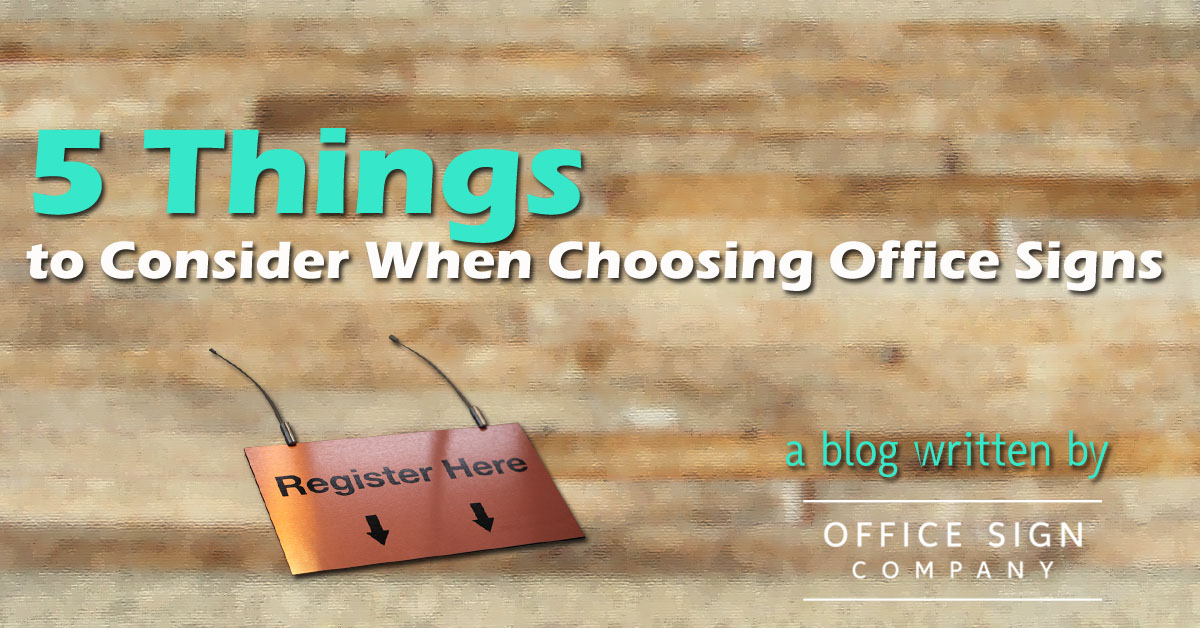
The search for new office signs can be nothing short of overwhelming. What may have once seemed like a trivial decision, finding door signs, nameplates, etc. that complemented one’s sparsely furnished workplace, has more meaning now than ever, given the climate of today’s aesthetic-centric business. “Creating a cool office space can and should reflect a company’s culture,” says Samantha Zupan from Glassdoor.“It can be a sense of pride for employees and an attractive selling point to recruits.” Quality signage is one of many components that contribute to the creation of a ‘cool’ office space; however, there are many considerations when selecting the signs that make up one’s office.
Not only does a purchasing department have to comply with the budget established by their accountants, but companies also need to align their signage with their company’s brand. As much as billboards and banners outside of a building can serve as a marketing tool, signage within the office can be equally important. From the etched vinyl on your conference room door, to the nameplate on your front desk, every sign that makes up your workplace should be thought of as an investment; an investment that returns in the form of increased employee satisfaction, and overall enhancement of company brand.
#1: Size
Size matters—even for signs! Have you ever been in a retail store, workplace, or other venue that has you squinting for directions? I’ve been to a number of locations whose door signs have had me questioning whether I need glasses or not. Although you would like to keep your material costs low by choosing a smaller sign size, it’s also important to remember that signs are a wayfinding device. When you can’t even read the letters that make up a sign, all of those wayfinding benefits are foregone. The size you choose will vary based on which kind of sign you are making: a large wall sign can exceed ten feet in width and still look sharp, whereas a door sign is confined to the size of the door and a vinyl is confined to the size of a window. With most office signs—directories, flush mounts, door signs, etc.—I would suggest playing around with what size to make the sign by measuring the surface on which you will mount the door, and practicing standing away at different distances. You want to make sure your sign is easily legible, but not obnoxiously large. Like I said, size matters.
#2: Shape/Style
One of the next things to consider is the shape and style of the signs you are looking for. One of the biggest factors here is determining which material to use—acrylic, wood, metal, PVC, other? It is important to do thorough research (or simply ask for expertise from your signmaker) in order to learn about the different qualities of each material. For example, the novice may be unaware of the fact that acrylic signs are waterproof, or the fact that bamboo is easier to clean than traditional hardwood. Once the material of sign is determined, shape can be discussed. For some businesses, this is an opportunity to get creative. Perhaps your company’s logo is in the form of a shape which you would like your indoor signage to emulate; maybe a simple rectangular sign with rounded edges befits you. Virtually any shape or style is possible—at Office Sign Co., I’ve always operated under the mantra “if you can dream it, we can route it.” Although you don’t want to compromise the professionalism of your workplace with too bizarre of a sign style, it is okay to get creative when choosing your shape and style.
#3: Color(s)
Another important consideration when it comes to choosing office signs is color. When meeting with clients, particularly clients that are inexperienced with sign purchasing, one of the first requests is always as follows: ‘we want somethingwith color.’ Vague as that may be, the sentiment is endearing. It is always great to hear that people view signage as an extension to their art collection—something that can add vibrancy to an office. With acrylics, it is quite easy to incorporate your company’s blues, greens, etc. as the primary or secondary sign color. With a sign that is engraved using wood or metal, choosing which color is a little bit more difficult. With woods, you must determine if you would like a warmer tone or darker finish. With metals, the choice is often between bronze, aluminum, and copper. Furthermore, you have to choose between a shiny or matte finish. As you can tell there is a lot that goes into this decision, and it truly should not be taken lightly. The colors that you choose will not only represent your brand, but will also begin to formulate a perception of your company into the mind of whomever walks through your office. That being said, you will want to make sure that you are making a good impression on your customers, employees, and more!
#4: Text
Okay, so now that you’ve figured out your sign’s size, style, and colors, it’s time to give consideration to the content which will make up your sign. When I speak of “text” as a topic to consider, I am referring to two different items: (1) the actual words on the sign and (2) the style of font and lettering that you use. Both, in my opinion, are of equal importance. Not only must you have quality content that makes up your sign, but it also needs to look good and mesh with your brand. The absolute worst thing that you could do is have a typo. Although sign companies with our kind of devotion to customer service will look for typos in customer orders, some high-volume companies will simply print whatever the customer asks them—regardless of whether you spelled Creative Director correctly or accidentally auto-typed “Cremated Director.” Not only is spelling and grammar important on signage, but the sign should also not be overcrowded with text. We’re human: we get bored easily. Engraving your entire mission statement into a 10”x10” sign, for example, is overkill. Make your words count. Furthermore, choose text that is appropriate for the given sign. You wouldn’t want to enter a conference room that is identified in Comic Sans, would you? If you wish to customize your font based on your company’s brand guide, that is acceptable, however I would never suggest deviating too far from the norm when it comes to font choice. If you want a worthwhile office sign, text is certainly a consideration.
#5: Application/Mounting
The final consideration when it comes to signage is the mounting. As much as we would love to tell you that a little masking tape will suffice, the way you put your sign on your wall, door, or window is important. It’s essentially the cherry on top when it comes to beautiful signage. A few of our most popular mounting options include double-sided foam tape, screw mounts, Velcro, and magnetic tape. Cubicle hangers and cubicle fangs can come in handy, too. If it is a window vinyl or cling that you are installing, it is important to follow instructions and have the necessary application materials—prep spray, tac spray, and a squeegee. To learn more about mounting options click here and if you are applying a vinyl product, check out this video. Ultimately, the way you mount your sign will depend on the type of signage you are installing. Regardless of what type of sign it is, the mounting process should not be taken for granted; a great sign is nothing without a quality mount.
Follow Office Sign Company on Facebook, Twitter, Google+, and Instagram for future pointers regarding signage. To read more of Office Sign Company’s blog, click here.
Written by: Jack Yakowicz,
Account Manager at Office Sign Company








